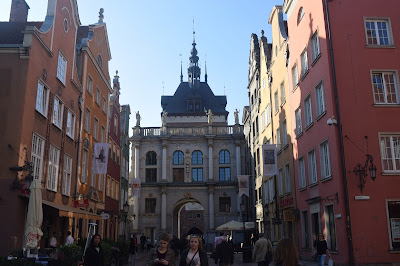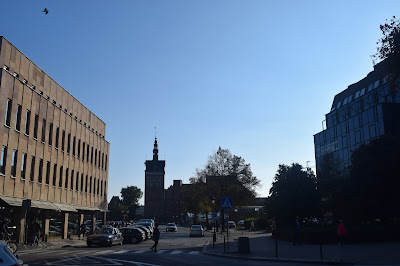Gdansk, Poland: The Unique Cultural Mix Part 2
The Free City of Danzig,
the former Gdańsk was a creation from the former German province of West
Prussia. The city was ironically, after the German defeat in First World War,
more German in a Polish state with a minority of Kashubian language along the
Baltic Sea. The city was a place of the mass exodus of the Polish and Jews
during the reign of the German Empire, and as well as that of the Germans after
the Allied Powers won before the Germans invaded it again during the Second
World War and expelled again during the Soviet occupation. This movement of
people could capture what the city is today, a bustling industrial port,
shipping building area and important Polish access commerce route along the
Baltic Sea. These are few of the reasons why I visited Gdańsk. This is Part
Two. Click here for Part One.
1.
Chmielna
The
Chnmielna Street is running entirely on Granary Island. The island opposite
where the Crane is located. There are museums in the street and recreational
facilities as well.
2.
Rybackie
Pobrzeże
The Fishing
Embankment is a street in Gdansk, which part of the Fish market. The name of
the street is derived from the Old Polish or Kashubian language.
3.
Długie
Pobrezeże
The Long
Bridge runs across the west bank of Motlawa. The site of the current pedestrian
zone were wooden platforms, used for landing and unloading ships.
4.
Brama
Mariacka
Mary’s gate
is one of the water gates of the Old Town. The water gate lost its military
importance and was converted into an apartment. It was damaged during the
Second World War.
5.
Żuraw.
Oddział Narodowego Muzeum
The Crane
along the Fishing Embarkment is a landmark of Gdansk, and is a reminder of what
is left of the city’s trading period. The Crane was destroyed several times
during wars and attacks in the city.
6.
Oddział
Zieloma Brama Muzeum
The Green
Gate is the most elegant square in the city. The architectural design was based
on Dutch style that has influenced the city’s characteristic style.
7.
Długi Targ
The Long
Market is the heart of the Old Town. This forms the Royal Route in the Medieval
Time. It has become the most important during the occupation of Danzig in the
13th century.
8.
Fontanna
Neptuna
The Neptune
Fountain is the most identified symbol of Gdansk. This was one of the adornment
in the square representing the god of the sea, Neptune. Neptune clearly
symbolizes the city as a fishing port and shipbuilding city on the Baltic Sea.
9.
Muzeum
Historyczne Miasta Gdańska
Gdansk Main
Town Hall is one of the example of Gothic-Renaissance historic buildings built
in 13th century. It is located along the Royal Route, where the
former kings of Poland goes when paying a visit in Gdansk.
10. Dwór Bractwa św. Jerzego
St. George
Brotherhood is the seat of confraternities in Gdansk, which was dissolved in
the 17th century, making the property of the city. It was also
destroyed during the Second World War.
11. Executioner's House, Prison Tower
The Wyżynna Gate is the first building on the so called Royal Route
that runs along Długa and Długa Targ streets towards the Green Gate to Granary
Island. In the lower part of the gate there were three arcaded
entrances, today two of them are bricked up.
12. Baszta Słomiana
The Straw
Tower was built for extra protection from attacks of the medieval Gdansk. The
current shape of the tower was built in the 15th century.
13. Teatr Wybrzeże
The Theater
Coast is Gdansk cultural center in Gdansk.
It is one of the most interesting post-World War II theaters. The
original theater was operated in the city of Gdynia before it was transferred
in the city.
14. Targ Drzewny
The Timber
Market is large rotunda where the statue of the polish king in 16th
century Is located. It is considered one of the oldest statue in the city,
which serves as an important landmark of the city.
15. Nadbałtyckie Centrum Kultury
The Baltic
Sea Culture Center aims to promote the culture of Pomerania in Poland,
representing the province in foreign cultural achievements, especially in the Baltic
countries.
16. Ławeczka Internetowa
This is the
park near the fountain of all the colors of the water and the Radunia channel.
The maritime and royal
history of Gdansk has been long and rich. It has been colorful as the stream of
history shifts in direction and purpose. Gdansk is actually a unique Polish
city because of its location. The unique cultural mixture of German, Old Polish,
Polish and other Europeans is a factor that make Gdansk a worth place to visit.



























Comments
Post a Comment